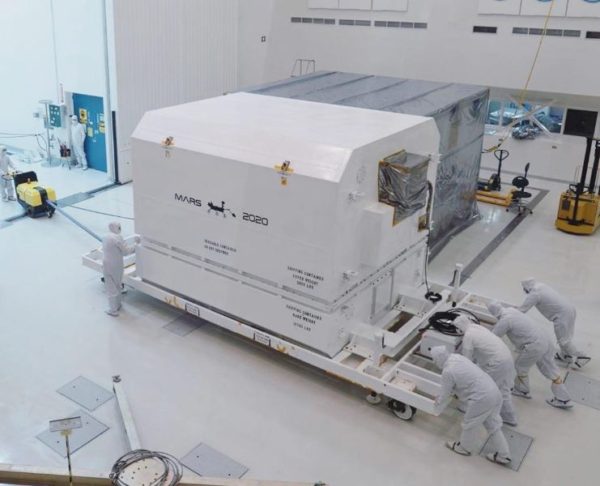
Jet Propulsion Laboratory in California (the institution founded by L. Ron Hubbard’s onetime colleague in magick, Jack Parsons) completed assembly of the newest Mars rover, provisionally designated “Mars 2020,” on Wednesday.
They transported it on a C-12 cargo plane to Kennedy Space Center in Florida, aiming for a tentative launch date of July 17 (but the launch window does not close until August 5). If it launches on time it will land on the red planet in January 2021 (each one-day delay in launch would delay the landing by more than a day, but even late in the launch window the arrival would be by March 2021).
Much of the equipment is based on prior rovers like Spirit and Curiosity. Like them, it will be given an inspirational name, but NASA has taken precautions to ensure that the naming contest does not end in a “Boaty McBoatFace” debacle. NASA did experience such an incident a decade ago when “Colbert” got more votes than “Xenu” for a space-station module, prompting Stephen Colbert to explain who Xenu allegedly was, and claim the title of Galactic Overlord.
A panel of judges vetted 28,000 proposed names, with short essays in support, gathered from K-12 students, selected 155 semi-finalists, and now have it narrowed down to 9 finalists: Endurance, Tenacity, Promise, Perseverance, Vision, Clarity, Ingenuity, Fortitude, Courage.
Over 770,000 votes were received (alas, voting closed January 27) and the winner will be announced sometime in March.
Surely the coolest piece of new equipment is an experimental helicopter on top. Generating enough lift, in an atmosphere only about 1 percent as thick as Earth’s, to hoist the whole rover, over a metric ton in mass (though that translates to only 38 percent as much weight, that is gravitational force, on Mars as it would on Earth), would be too difficult. This trial version will detach and fly with no payload, but if it works, on future missions copters may be used to deliver small instrument packages to hard-to-reach places.
The rover itself has a plutonium power source (energy from the radioactivity only, not a fission reactor) but the copter is intended to draw its power just from solar panels (sunlight on Mars is only 40 percent as much energy per area per time as on Earth). But the scientific instruments are designed to get a better handle on some of the most exciting questions about Mars. The landing site is at the mouth of an ancient river delta on the west end of Jezero Crater in a corner of the Isidia Basin region…

Jezero is named, in keeping with a NASA practice of using the names of small towns for particularly interesting sites, for a Bosnian village which means “lake” in Serbo-Croatian (the initial J should be pronounced “y” but a lot of NASA and JPL spokespeople have fallen into the habit of pronouncing it with the English “j” sound). The crater must, indeed, have been a lake when the river still flowed, although that stopped billions of years ago (“how many billions?” is one of the questions still unanswered). The rover will drill deep to take core samples and measure how much water ice remains in various layers, and whether there is any liquid water or fossil life anywhere.
Could there be any surviving life on Mars? Hopes for this have faded. Early in the 20th century, Schiaparelli’s observation of “canali” (Italian for “channels”) on Mars got mistranslated into English as “canals”; this excited the eccentric American astronomer Percival Lowell into theorizing about Martian civilization desperately trying to conserve dwindling water supplies. Lowell’s maps showed not only the genuine, long fracture lines which are found on the planet, like the Nili Fossae near Jezero Crater, but numerous lines which his imagination posited. By 1952 it was clear that Mars was much less hospitable than Lowell and sci-fi writers like Edgar Rice Burroughs and H. G. Wells expected it to be, but because of seasonal changes in the visual appearance of the hemispheres, popular science writer Willy Ley wrote, “Most astronomers agree that there is primitive plant life, like algae and lichens, on Mars.” Sci-fi writer Isaac Asimov responded, “Algae? Lichens? We were promised princesses!”
The 1965 Mariner orbiter made it clear that the seasonal changes were only windstorms moving the dust back and forth. The 1976 Viking landers carried the “Labelled Release” experiment which was supposed to test Martian soil for signs of bacterial life: the results were not what was expected whether there was life or not, and most think it detected weird soil chemistry (peroxides and perchlorates that can release oxygen). But Gilbert Levin, who designed the experiment, still persists in the position that he found evidence for life.
In 1984 a meteorite (Allan Hills 84001) was identified as having been knocked off of Mars. Examination found microscopic chains of bubbles which could be interpreted as small bacterial cells, although there are other explanations, associated with magnetite crystals such as some bacteria form, but again skeptics doubt the biological explanation.
What we really need is for a sample of the Martian soil to be brought back. And the new rover will prepare for this, putting some of its core drills into a capsule for a future mission to retrieve. The basic problem is that a round trip does not double the fuel requirement, like a long drive to a place where you can stop at a gas station to refill, but squares it. Consider driving across a continent with no gas stations: carrying enough fuel for the trip adds weight which requires more fuel in turn, so perhaps only a tanker truck would do; but then, if you need to deliver a full tanker tank to the other end, so you can come back, then you need a fleet of tanker trucks to set out. If a rocket must have ten times the payload mass to make the trip, then it would have to have a hundred times the payload mass to deliver ten times the
payload mass at the other end. But NASA is collaborating with ESA (European Space Agency) on a mission some years down the road to deliver an orbiter to Mars, with enough fuel to get back, which will drop a small rocket down, with enough fuel to get back up to the orbiter and a little “fetch rover” to go grab the capsule the Mars 2020 rover will gather.
The “fetch rover” has to be part of the plan because, although previous rovers have outlived their nominal lifespan to an amazing extent, that can’t be relied on. The Mars 2020 rover is designed to last a Martian year (almost 2 Earth years). One more thing it will try to do is break carbon dioxide into carbon and oxygen to see if this is a feasible way to make air for a human habitat: of course, this costs as much energy as burning carbon produces, so it will not do too much of this. But we are finally taking baby steps towards sending people to Mars and bringing them back, and towards sending people to Mars who can live there long-term. The geeky joke is that “Mars is the only planet which, so far as we know, is inhabited only by robots.” Perhaps this will change, either because we learn that there is life on Mars, or because we are finally able to send life there.
Robert Eckert is a longtime member of the Underground Bunker community and author of the historical novel The Year of Five Emperors.






